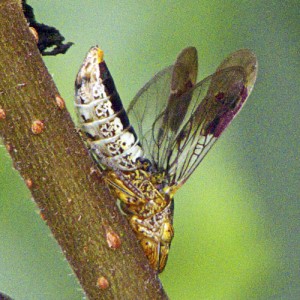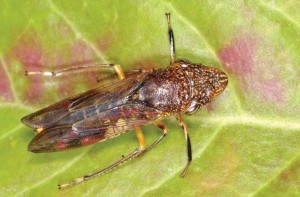The glassy-winged sharpshooter is a large leafhopper species native to the southeastern United States. It is one of the main vectors of the bacterium Xylella fastidiosa, a plant pathogen that causes a variety of plant diseases, including phony peach disease of peach and Pierce’s disease of grape. It obtains its nutrients by feeding on plant fluids in the water-conducting tissues of a plant. Feeding on plants rarely causes significant plant damage, although the insects do excrete copious amounts of liquid that can make leaves and fruit appear whitewashed when dry. The excrement is a special nuisance when shade trees are heavily infested because cars parked under the trees tend to become spotted. During hot weather, heavy populations of glassy-winged sharpshooters feeding on small plants may cause them to wilt.
 The real problem associated with a glassy-winged sharpshooter, however, is that it can spread the disease-causing bacterium Xylella fastidiosa from one plant to another. This bacterium is the causal agent of devastating plant diseases such as Pierce’s disease of grape, oleander leaf scorch, almond leaf scorch and mulberry leaf scorch. Other diseases to landscape plants in California include sweet gum dieback and cherry plum leaf scorch. When a glassy-winged sharpshooter feeds on a plant that is infected with X. fastidiosa, it acquires the bacteria, which multiplies within the insect’s mouthparts. The sharpshooter then transfers the bacteria to another plant when it feeds. The glassy-winged sharpshooter feeds on plants through straw-like mouthparts inserted into the xylem tissue which conducts water throughout the plant. Because nutrients are diluted in xylem fluid, the insect must process large volumes to meet nutritional needs. Thus, this pest produces copious amounts of watery excreta and is a social nuisance as the liquid rains down from large populations feeding on ornamental trees.
The real problem associated with a glassy-winged sharpshooter, however, is that it can spread the disease-causing bacterium Xylella fastidiosa from one plant to another. This bacterium is the causal agent of devastating plant diseases such as Pierce’s disease of grape, oleander leaf scorch, almond leaf scorch and mulberry leaf scorch. Other diseases to landscape plants in California include sweet gum dieback and cherry plum leaf scorch. When a glassy-winged sharpshooter feeds on a plant that is infected with X. fastidiosa, it acquires the bacteria, which multiplies within the insect’s mouthparts. The sharpshooter then transfers the bacteria to another plant when it feeds. The glassy-winged sharpshooter feeds on plants through straw-like mouthparts inserted into the xylem tissue which conducts water throughout the plant. Because nutrients are diluted in xylem fluid, the insect must process large volumes to meet nutritional needs. Thus, this pest produces copious amounts of watery excreta and is a social nuisance as the liquid rains down from large populations feeding on ornamental trees.
In infested citrus orchards, tree canopies take on a white-washed appearance by mid-summer due to the buildup of residues after the evaporation of these watery excreta. Different strains of this bacterium induce severe diseases in many agricultural and ornamental plants. In ornamental horticulture, an important part of the landscape in the southwest will be lost if oleander leaf scorch continues to spread and resistant oleander varieties are not found. Oleander is found in 20% of all home gardens in California and is a mainstay of landscapes in shopping centers, parks, and golf courses. It is estimated that Caltrans alone stands to suffer at least a $52 million loss if oleander on highway plantings is lost. In the city of Tustin (Orange County), approximately $200,000 was requisitioned to pay for removal of oleanders maintained on city greenbelts and for replanting other ornamental species. Another huge economic problem lies in the transport of ornamentals by wholesale nurseries as this industry is subjected to rigorous inspections and mandatory insecticide applications to minimize the accidental shipment of the glassy-winged sharpshooter into uninfested areas of California. The Agriculture Appropriation Act of 2002 included $8.5 million in funding for controlling the glassy-winged sharpshooter.
The below article would better explain these menacing insects.
Pesky, destructive insect discovered in Marin
March 13, 2015
By Chris Rooney
As if unreliable weather patterns aren’t enough to drive grape growers over the edge, a new threat for vintners has reared its ugly head in Marin County — the glassy-winged sharpshooter.
“People need to know how devastating this pest can be,” Marin County Agricultural Commissioner Stacy Carlsen said. “We want to keep it out of the county.”
The destructive insect sucks the fluids out of plants and can wreak horticultural havoc in agricultural areas. One critter was recently found in Marin County during a routine inspection of a nursery shipment from Ventura County.
Despite thorough efforts to inspect plants being shipped from southern California to local nurseries, Carlsen said the sharpshooter can sneak by.
“Check your plants and make sure there are no hitchhikers,” Carlsen said.
 Carlsen reported that an agricultural program assistant with the Marin County Department of Agriculture captured an adult glassy-winged sharpshooter on Feb. 26 while checking an incoming plant shipment.
Carlsen reported that an agricultural program assistant with the Marin County Department of Agriculture captured an adult glassy-winged sharpshooter on Feb. 26 while checking an incoming plant shipment.
According to a Bay City News report, that shipment has since been returned, but the name of the nursery that sent it is being withheld to prevent unwanted attention, according to the Department of Agriculture.
The species damages a wide variety of plants and spreads lethal diseases to crops such as almonds and grapes for which there are no known cures.
According to the University of California Integrated Pest Management Program, the glassy-winged sharpshooter, Homalodisca vitripennis, is an insect that was inadvertently introduced into southern California in the early 1990s.
It is native to the southeastern United States and was most likely brought into California accidentally as egg masses in ornamental or agricultural plant foliage.
The real problem associated with a glassy-winged sharpshooter, however, is that it can spread the disease-causing bacterium, Xylella fastidiosa, from one plant to another. This bacterium is the causal agent of devastating plant diseases such as Pierce’s disease of grape, oleander leaf scorch, almond leaf scorch and mulberry leaf scorch. Other diseases to landscape plants in California include sweet gum dieback and cherry plum leaf scorch.
The principal reason for controlling the glassy-winged sharpshooter is to prevent the spread of the Xylella bacterium to susceptible plants. Because very low numbers of sharpshooters can spread the disease, it is not known how effective insecticides applied to suppress sharpshooters will be in controlling disease spread; research is currently underway to study this issue.
The current strategy for containing the problem is to keep the insect out of new areas.
What we need is a solution which would effectively keep the glassy-winged sharpshooter population in check, keeping them away from our trees, while at the same time not having any negative impact on the environment.
Hence to help alleviate or else completely eradicate the infestation we C Tech Corporation provide you with the best effective solution Combirepel™.Combirepel™ is an anti-insect aversive developed on the grounds of green chemistry and technology.
Our product works on the mechanism of repellency. It temporarily inhibits the mating cycle of the insects. The product impairs the ability of the insects to reproduce, that is the insects will not lay eggs or the laid eggs will be infertile. The product causes feeding disruption in an insect by triggering an unpleasant reaction within the insect which might try to feed on the application. The product temporarily blocks the reproduction system of the insects by hindering the release of the vital hormones for growth.
Combirepel™ is thermally stable and does not degrade on exposure to heat and sunlight. It does not kill or harm the insect but repels them. It does not volatilize and does not degrade the soil. It is RoHS, RoHS2, ISO, REACH, APVMA, NEA compliant and FIFRA exempted.
Combirepel™ is an eco-friendly product which acts as an aversive to repel the pesky insects like roaches. Combirepel™ do not kill the targeted as well as non-targeted species but just repel them causing no harm no to human and environment.
Combirepel™ is available in the form of masterbatch, liquid concentrate, and lacquer. Our Combirepel™ masterbatch can be used in polymer base applications like wires, cables, irrigation pipes, polymeric vessels, and other various applications.
Combirepel™ liquid concentrate can be mixed in the paints to cover the areas like cracks and crevices of walls and hidden places where the roaches tend to survive.
Combirepel™ lacquer is the topical coating to cover the places like bathrooms, cupboards, steam tunnels, etc.
Hence we provide you with the best effective solution.
Contact us as technical.marketing@ctechcorporation.com to get solution on pest nuisance.
Also, visit our websites:
http://www.ctechcorporation.com/
http://www.rodrepel.com/
http://www.termirepel.com/
http://www.combirepel.com/
Follow our Facebook pages at:
1] https://www.facebook.com/Combirepel-411710912249274/
2] https://www.facebook.com/Termirepel-104225413091251/
3] https://www.facebook.com/Rodrepel-120734974768048/
Follow us on our Twitter pages at:
1] https://twitter.com/rodrepel
2] https://twitter.com/termirepel
3] https://twitter.com/combirepel
